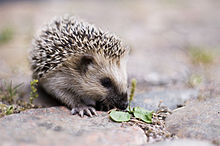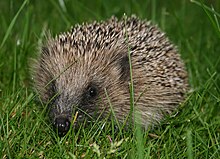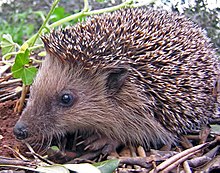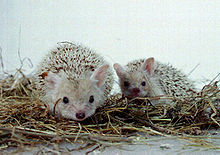Hedgehog
| Hedgehogs[1] | |
|---|---|

| |
| European hedgehog | |
| Scientific classification | |
| Kingdom: | |
| Phylum: | |
| Class: | |
| Order: | |
| Family: | |
| Subfamily: | Erinaceinae G. Fischer, 1814
|
| Genera | |
A hedgehog is any of the spiny mammals of the subfamily Erinaceinae, which is in order Erinaceomorpha. There are seventeen species of hedgehog in five genera, found through parts of Europe, Asia, Africa and New Zealand (by introduction). There are no hedgehogs native to Australia, and no living species native to the Americas. Hedgehogs share distant ancestry with shrews (order Soricidae), with gymnures possibly being the intermediate link, and have changed little over the last 15 million years.[2] Like many of the first mammals they have adapted to a nocturnal,[3] insectivorous way of life. Hedgehogs' spiny protection resembles that of the unrelated rodent porcupines and monotreme echidnas.
The name hedgehog came into use around the year 1450, derived from the Middle English heyghoge, from heyg, hegge ("hedge"), because it frequents hedgerows, and hoge, hogge ("hog"), from its piglike snout.[4] Other names include urchin, hedgepig and furze-pig.
Physical description
Hedgehogs are easily recognized by their spines, which are hollow hairs made stiff with keratin. Their spines are not poisonous or barbed and, unlike the quills of a porcupine, cannot easily be removed from the hedgehog. However, spines normally come out when a hedgehog sheds baby spines and replaces them with adult spines. This is called "quilling". When under extreme stress or during sickness, a hedgehog can also lose spines.



A defense that all species of hedgehogs possess is the ability to roll into a tight ball, causing all of the spines to point outwards. However, its effectiveness depends on the number of spines, and since some of the desert hedgehogs evolved to carry less weight, they are much more likely to try to run away and sometimes even attack the intruder, trying to ram into the intruder with its spines, and rolling as a last resort. This results in a different number of predators for different species: while forest hedgehogs have relatively few, primarily birds (especially owls) and ferrets, smaller species like the long-eared hedgehog are preyed on by foxes, wolves and mongooses.
Hedgehogs are primarily nocturnal, although, depending on the species, they may be more or less active during the day. The hedgehog sleeps for a large portion of the daytime either under cover of bush, grass, rock or in a hole in the ground. Again, different species can have slightly different habits, but in general hedgehogs dig dens for shelter. All wild hedgehogs can hibernate, although not all do; hibernation depends on temperature, species, and abundance of food.
The hedgehog's back is made up of two large muscles, which control the positioning of its quills. There are about 5,000 to 6,500 quills on the average hedgehog, and these are durable on the outside, while being filled with air pockets on the inside. The hedgehog uses its quills to protect itself from predators, using muscles which draw their quilled skin to cover their full body, and pulling in the parts of their bodies not covered, such as their head, feet, and belly.[5] This form of defense is the hedgehog's most successful, but is usually their last resort.
Hedgehogs are fairly vocal and communicate through a combination of grunts, snuffles and/or squeals, depending on species.

Hedgehogs occasionally perform a ritual called anointing. When the animal encounters a new scent, it will lick and bite the source, then form a scented froth in its mouth and paste it on its spines with its tongue. The specific purpose of this ritual is unknown, but some experts believe anointing camouflages the hedgehog with the new scent of the area and provides a possible poison or source of infection to predators poked by their spines. Anointing is sometimes also called anting because of a similar behavior in birds.
Similar to opossums, mice and moles, hedgehogs have some natural immunity against snake venom due to the protein erinacin in the animal's muscular system (although it is only available in small percentage and a viper bite, for example, may kill the hedgehog anyway).[6]
Diet

Although traditionally classified in the now abandoned order Insectivora, hedgehogs are not exclusively insectivores but are almost omnivorous. Hedgehogs feed on insects, snails, frogs and toads, snakes, bird eggs, carrion, mushrooms, grass roots, berries, melons and watermelons. Berries constitute a major part of an Afghan hedgehog's diet in early spring after hibernation.
Reproduction and lifespan

Depending on the species, the gestation period is 35–58 days. The average litter is 3–4 newborns for larger species and 5–6 for smaller ones. As with many animals, it is not unusual for an adult male hedgehog to kill newborn males.
Hedgehogs have a relatively long lifespan for their size. Larger species of hedgehogs live 4–7 years in the wild (some have been recorded up to 16 years), and smaller species live 2–4 years (4–7 in captivity), compared to a mouse at 2 years and a large rat at 3–5 years. Lack of predators and controlled diet contribute to a longer lifespan in captivity (8–10 years depending on size).
Hedgehogs are born blind. The hedgehogs are birthed with a protective membrane covering their quills, which dries and shrinks over the next several hours.[7] The infants are born with quills beneath the skin, like pimples, and pass the skin after they have been cleaned.[8]
Predators
Hedgehog bones have been found in the pellets of the European Eagle Owl.[9]
Domesticated hedgehogs

The most common pet species of hedgehog are hybrids of the white-bellied hedgehog or four-toed hedgehog (Atelerix albiventris) and the North African hedgehog (A. algirus). It is smaller than the European hedgehog, and thus is sometimes called the African pygmy hedgehog. Other species kept as pets are the long-eared hedgehog (Hemiechinus auritus) and the Indian long-eared hedgehog (H. collaris).
It is illegal to own a hedgehog as a pet in some US states and some Canadian municipalities, and breeding licenses are required. No such restrictions exist in most European countries with the exception of Scandinavia. However, in the UK wild hedgehogs are considered endangered and it is illegal to keep one as a pet.[10]
Invasive species
In areas where hedgehogs have been introduced, such as New Zealand and the islands of Scotland, the hedgehog itself has become a pest. In New Zealand it causes immense damage to native species including insects, snails, lizards and ground-nesting birds, particularly shore birds. As with many introduced animals, it lacks natural predators. With overpopulation, it kills off more insects than initially intended and expands its diet to include things such as snails, worms and the eggs of wading birds.
Correcting overpopulation is troublesome itself. Attempts to eliminate hedgehogs from bird colonies on the Scottish islands of North Uist and Benbecula in the Outer Hebrides were met with international outrage. Eradication began in 2003 with 690 hedgehogs being killed. Animal welfare groups attempted rescues to save the hedgehogs. By 2007, legal injunctions against the killing of hedgehogs were put in place. In 2008, the elimination process was changed from killing the hedgehogs to trapping them and releasing on the mainland.[11]
Hedgehog diseases
Hedgehogs suffer many diseases common to humans.[12] These include cancer, fatty liver disease and cardiovascular disease.
Cancer is very common in hedgehogs. The most common is squamous cell carcinoma. Squamous cell spreads quickly from the bone to the organs in hedgehogs, unlike in humans. Surgery to remove the tumors is rare because it would result in removing too much bone structure.
Fatty liver disease is believed by many to be caused by bad diet. Hedgehogs will eagerly eat foods that are high in fat and sugar. Having a metabolism adapted for low-fat, protein-rich insects, this leads to common problems of obesity. Fatty liver disease is one sign, heart disease is another.
Hedgehogs uncommonly transmit a characteristic fungal skin infection to human handlers as well as other hedgehogs. This ringworm or dermatophytosis infection is caused by Trichophyton erinacei, which forms a distinct mating group within the Arthroderma benhamiae species complex.[13]
Human influence

As with most small mammals living around humans, cars pose a great threat to hedgehogs. Many are run over as they attempt to cross roadways.

In 2006, McDonald's changed the design of their McFlurry containers to be more hedgehog-friendly.[14] Previously, hedgehogs would get their heads stuck in the container as they tried to lick the remaining food from inside the cup. Then, being unable to get out, they would starve to death. Domesticated hedgehogs display this behavior by getting their head stuck in tubes (commonly, lavatory paper tubes) and walking around with the tube on their head. Hedgehog owners often refer to this as "tubing" and promote the behavior by supplying clean tubes. Most owners are considerate enough, however, to cut the tubes lengthwise so as to prevent the hedgehog from remaining trapped against their will. Curiously though, some will still knowingly get themselves stuck for a few hours.[15]
Culinary and medicinal use
Hedgehogs are a food source in many cultures. Hedgehogs were eaten in Ancient Egypt and some recipes of the Late Middle Ages call for hedgehog meat.[16] In the Middle East and especially among Bedouins, hedgehog meat is considered medicinal, and thought to cure rheumatism and arthritis.[17] Romani people supposedly still eat it, boiled or roasted, and also use the blood and the fat for its supposed medicinal value.[18] During the 1980s, "hedgehog-flavour" crisps were introduced in Britain, although the product did not contain any hedgehog.[19]
Genera and species


Subfamily Erinaceinae (Hedgehogs)[1]
- Genus Atelerix
- Four-toed hedgehog, Atelerix albiventris
- North African hedgehog, Atelerix algirus
- Southern African hedgehog, Atelerix frontalis
- Somali hedgehog, Atelerix sclateri
- Genus Erinaceus
- Amur hedgehog, Erinaceus amurensis
- Southern white-breasted hedgehog, Erinaceus concolor
- European hedgehog, Erinaceus europaeus
- Northern white-breasted hedgehog, Erinaceus roumanicus
- Genus Hemiechinus
- Long-eared hedgehog, Hemiechinus auritus
- Indian long-eared hedgehog, Hemiechinus collaris
- Genus Mesechinus
- Daurian hedgehog, Mesechinus dauuricus
- Hugh's hedgehog, Mesechinus hughi
- Genus Paraechinus
- Desert hedgehog, Paraechinus aethiopicus
- Brandt's hedgehog, Paraechinus hypomelas
- Indian hedgehog, Paraechinus micropus
- Bare-bellied hedgehog, Paraechinus nudiventris
See also
- Echidnas or "spiny anteaters", members of the order Monotremata that have spines
- Hedgehog's dilemma
- Hedgehogs in culture
- Porcupines, two different rodent families which have spines or quills
References
- ^ a b Hutterer, R. (2005). "Order Erinaceomorpha". In Wilson, D.E.; Reeder, D.M (eds.). Mammal Species of the World: A Taxonomic and Geographic Reference (3rd ed.). Johns Hopkins University Press. pp. 212–217. ISBN 978-0-8018-8221-0. OCLC 62265494.
- ^ Reiter C, Gould GC, "Thirteen Ways of Looking at a Hedgehog" Natural History, Jul–Aug 1998
- ^ "WildlifeTrust.org.uk". WildlifeTrust.org.uk. Retrieved 28 February 2013.
- ^ Oxford English Dictionary, Online edition. Retrieved 13 July 2007.
- ^ "National wildlife Federation". Lisa W. Drew.
- ^ Omori-Satoha, Tamotsu (2000). "The antihemorrhagic factor, erinacin, from the European hedgehog (Erinaceus europaeus), a metalloprotease inhibitor of large molecular size possessing ficolin/opsonin P35 lectin domains". Toxicon. 38 (11): 1561–80. doi:10.1016/S0041-0101(00)00090-8. ISSN 0041-0101. PMID 10775756.
{{cite journal}}: Unknown parameter|coauthors=ignored (|author=suggested) (help); Unknown parameter|month=ignored (help) - ^ Baby hedgehogs less than five hours old.
- ^ "The Hedghogz Home Page – Babies & Reproduction". Hedghogz.co.uk. Retrieved 8 March 2009.
- ^ Social Behaviour / Territoriality / Predation / Learning: West European Hedgehog[dead link]
- ^ "Facts about British Hedgehog". Retrieved 16 January 2011.
- ^ Ross, David (14 January 2009). "18 Trappers Sought for Hebrides to Protect Birds from Hedgehogs". The Herald. Retrieved 12 June 2009.
- ^ "List of Hedgehog diseases". Wildlifeinformation.org. Retrieved 8 March 2009.
- ^ Takahashi, Yoko (2003). "The epidemiology and mating behavior of Arthroderma benhamiae var. erinacei in household four-toed hedgehogs (Atelerix albiventris) in Japan" (PDF). Japanese Journal of Medical Mycology. 44 (1): 31–8. doi:10.3314/jjmm.44.31. ISSN 0916-4804. PMID 12590257.
{{cite journal}}: Unknown parameter|coauthors=ignored (|author=suggested) (help) - ^ Lean, Geoffrey (10 September 2006). "Hedgehogs saved from death by McFlurry". The Independent. London. Retrieved 21 May 2009.
- ^ "A community for African Pygmy Hedgehog Owners and Breeders – Environmental Enrichment". Hedgehog World. Archived from the original on 15 January 2008. Retrieved 8 March 2009.
- ^ Pidd, Helen (14 September 2007). "Roast hedgehog and nettle pud – a slap-up feast for ancient Britons". The Guardian. London. Retrieved 12 June 2009.
- ^ Qumsiyeh, Mazin B. (1996). Mammals of the Holy Land. Texas Tech UP. p. 64. ISBN 978-0-89672-364-1.
- ^ Wood, Manfri Frederick (1979–2006). In the Life of a Romany Gypsy. J.A. Brune. pp. 80–81. ISBN 978-0-7100-0197-9.
{{cite book}}: CS1 maint: date and year (link) - ^ "Potato Crisps – A History". BBC. 7 December 2002. Retrieved 22 March 2010.
